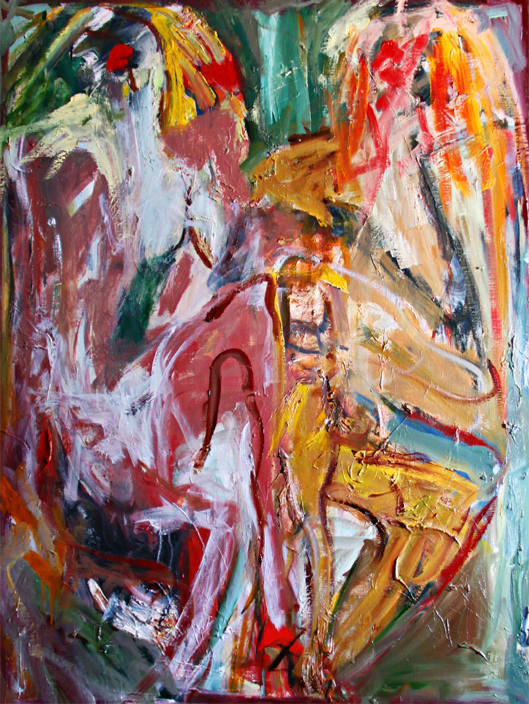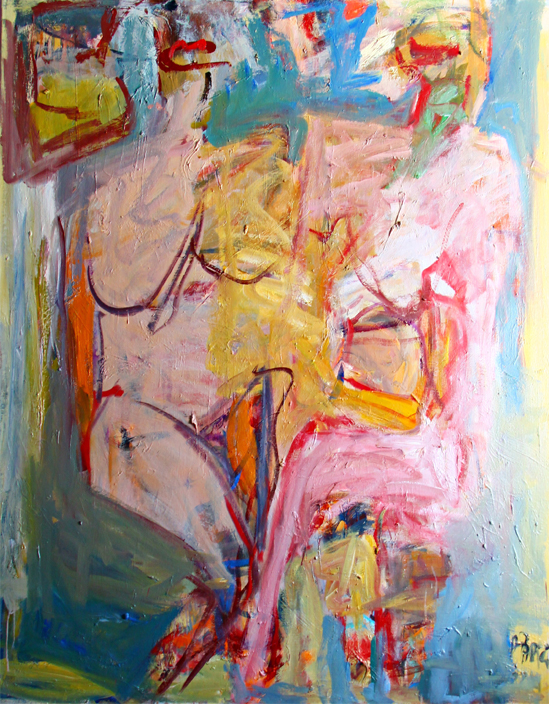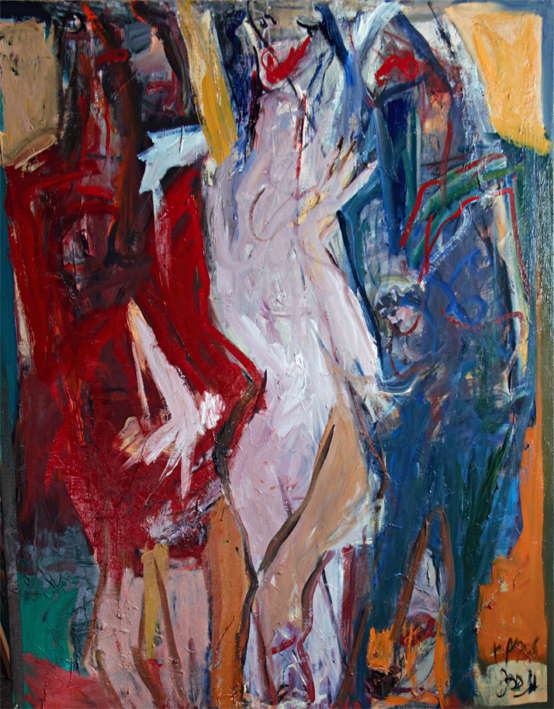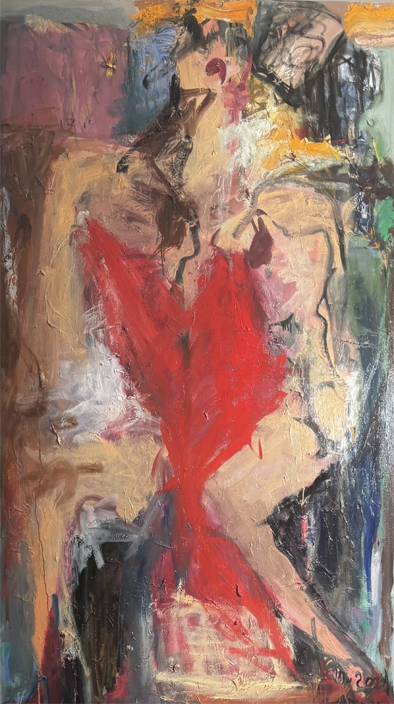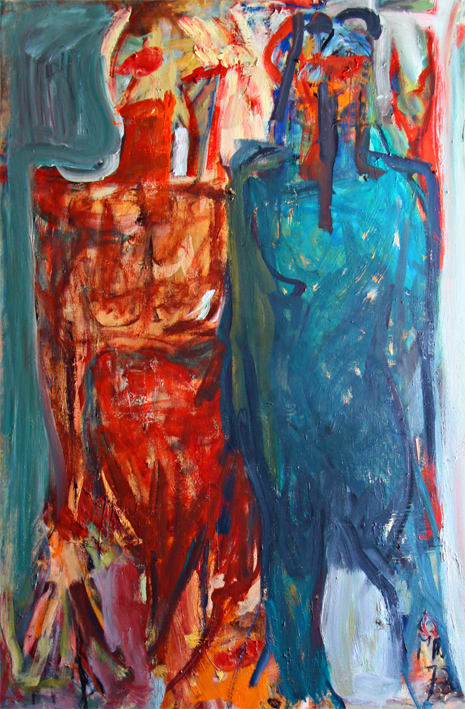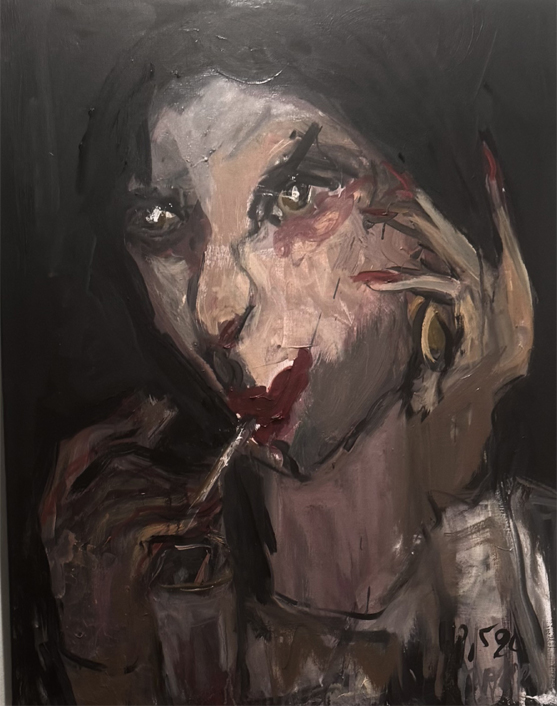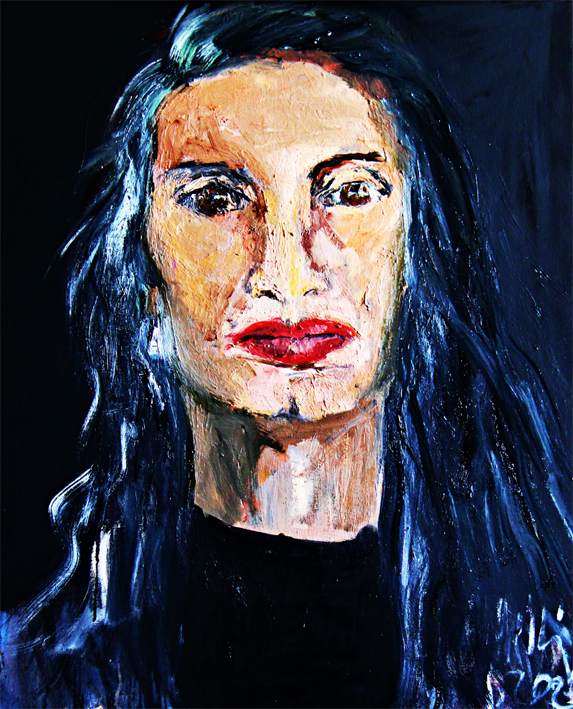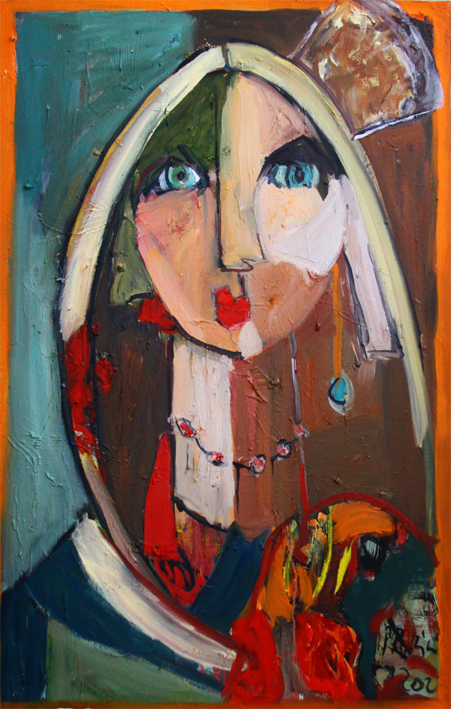MARIA APARICI
Del 3 al 22 febrero de 2025
MARIA APARICI
Del 3 al 22 de febrero de 2025
PASIÓN, REBELDÍA Y SUFRIMIENTO DE MARÍA APARICI.
La obra de Maria Aparici es flujo de la historia del arte, de su biografía y de su presente, porque en la misma queda registrada una realidad de lo que ve y otro de lo que recuerda, además de la memoria encarnada en su vértigo expresionista.
En su plástica no hay una huida de su libertad existencial, sino un enfrentamiento que culmine en un significado de la forma, en la luz que ilumina su visión cromática, en la catarsis y en la metamorfosis que generan y adquieren en sus cuerpos esbozados una formulación que produce en la mirada del que se acerca una experiencia del cómo, cuándo y qué.
Su trabajo es perturbador y provocador, fruto de un ethos creativo también devastador, de una pasión capaz de vivir y sentirse viva, aunque asimismo de un espíritu que es materia elevada al rango de sufrimiento (Cioran), sin que deje de mostrar esa dimensión simbólica que caracteriza a la verdad de lo que se contempla.
No hay medio de escapar de su intensidad pictórica, tan densa, tan texturizada, tan aparentemente invertebrada que cuando se plasma en la superficie, no sólo no está quebrantada, si no que es un todo que se conjuga como una imagen compacta y angustiosamente definida.
Sus mujeres sufren, pero no lloran; gimen, pero no exhalan lamentos; resisten, pero sin arrodillarse; son lo que son porque son verdad, y refuerzan su sensibilidad a la hora de atribuirse un destino que pese a anularlas las hace más fuertes.
Lo cual nos lleva a una producción, la de Aparici, que recaba sobre sí una percepción exigente que despierta emoción, reflexión y un pensamiento en continua exploración de su interior vital. Es poesía visual atada al delirio.
Gregorio Vigil-Escalera
De las Asociaciones Internacional y Española de Críticos de Arte (AICA/AECA)
.
Hidden Moralities
To encounter Maria Aparici’s latest collection is to step into a battlefield where the canvas itself becomes the site of rebellion. This award-winning artist, whose roots trace back to Valencia -the land that birthed the great Joaquín Sorolla- uses her oil-on-canvas works to shatter conventions, challenging both aesthetic traditions and the cultural mores that define femininity in the modern world. Aparici’s lineage and formal education, enriched by a sojourn in the United States, lend her work a striking duality: it is both a nod to classical mastery and a bold march into uncharted territories of abstraction, expressionism, and feminist ideology. At first glance, Aparici’s work might appear dynamic and untamed -her brushstrokes bold and expressive, her figures strikingly unconventional. But closer inspection reveals an extraordinary depth and coherence. Through distortion and abstraction, Aparici achieves something remarkable: she articulates the inexpressible.
In her collection, the female form becomes a visual language of defiance. Take, for instance, the painting where a figure draped in red emerges from a storm of violent, tangled brushwork. Here, red is not just a color; it is a scream, a pulse, a declaration of life and rage. The figure, stretched and contorted, seems to exist in a liminal space between destruction and rebirth. Aparici invites us to see the grotesque not as a flaw, but as an inevitable consequence of the pressures society exerts on women. In doing so, she aligns herself with the legacy of Egon Schiele, whose angular, unvarnished depictions of the human body shocked the art world in the early 20th century. Yet Aparici takes this ethos further, layering her feminist critique with a profound psychological insight.
Aparici’s themes are deeply autobiographical, as her artist statement makes clear. She speaks of women’s bodies as “merchandise, admired or reviled, consumed or restricted without mercy.
In one particularly haunting work, two figures share a canvas, their bodies rendered in broad, gestural strokes that convey both intimacy and alienation. The palette -a juxtaposition of soft pastels and harsh reds- suggests both vulnerability and violence. It is a conversation between two women, or perhaps between the self and its fragmented reflection.
Aparici’s exploration of the grotesque also carries a redemptive quality. By embracing what society deems “ugly” or “imperfect,” she challenges the very notion of perfection. This is particularly evident in a work where a pair of female figures, their forms nearly obliterated by abstraction, seem to dissolve into a swirl of color. It is as if Aparici is suggesting that identity, though fragile, cannot be erased. In the chaos of the painting, there is a quiet resilience.
Portraits
Her portraiture, too, is arresting. A piece featuring a woman with piercing eyes and a striking red mouth is both confrontational and intimate. The heavy impasto and thick, almost sculptural application of paint give the work a physicality that draws the viewer in. This is not a face meant top leaseorto be consumed; it is a face that demands to be seen on its own terms. Aparici’s portraits stand as a rebuttal to the centuries-old tradition of the “male gaze” in art history. Here, the subject is not an object of desire but a fully realized individual, brimming with complexity.
In herportrait Angela Molina, the textured layers of impasto create a táctil equality, inviting the viewer into an intimate dialogue with the subject. The portrait transcends traditional representation, focusing not on physical perfection but one motional and psychological depth. The red lips, stark against the muted background, symbolize defiance and strength, encapsulating Aparici’s vision of reclaiming the female narrative.
Marta Puig
Contemporary Art Curator Magazine, diciembre 2024.
.
María Aparici estudia en la Escuela de Artes Aplicadas de Burgos. Se traslada a Estados Unidos, donde completa su formación graduándose en interiorismo en la New School for Social Research de Nueva York (1988-1992). Ya en Madrid, sigue estudios de pintura con Amadeo Roca, y se licencia en Bellas Artes, especialidad de pintura, por la Universidad Complutense (1998).
Realiza exposiciones individuales en Davos (Suiza) (1998) y en Cincinnati, Ohio (Estados Unidos) (2001), país donde ha participado también en numerosas colectivas, especialmente en Nueva York: Montserrat Gallery (2000), Ward-Nasse Gallery (2000, 2001, 2002) y Chelsea Gallery (2003), además de la feria de arte neoyorkina Artexpo (2001).
En España caben destacar sus muestras personales en las galerías Victoria Hidalgo (2000) y Orfila (2004, 2006, 2014, 2020, 2022), Madrid; Galería Agurcho Iruretagoyena, Pamplona (2004); Galería Akka, Valencia (2005).
Participa en las ferias InterArte, Valencia (2000); Arte Santander (2001); Arte Sevilla y Arte Madrid (2004); FIABCN, Barcelona (2016, 2021); ITSLIQUID International Art Fair: Contemporary Venice (2021); Paris Art Fair, con Monat Gallery (2021); Art3F International Contemporary Art Fair, París (2022); Salon international d’Art Contemporain, Luxemburgo (2022). En los últimos años desarrolla una amplia actividad, concurriendo a colectivas como Women’s Essence, Fundación Pons, Madrid (2018), 4rd International Bienal de Arte Barcelona, MEAM, Museo Europeo de Arte Moderno (2022), así como, a nivel internacional, en otras celebradas en Londres, Berlín, Pescia y Milán (Italia), Nueva Delhi (India), Basel y Montreux (Suiza), Lisboa, Roma…
Entre 2023 y 2024 realiza exposiciones digitales en: Miami Red Art Fair; Effeito Arte Fondazione with Salvatore Russo, Washington (USA); Montreux Art Gallery MAG y Art Basel (Suiza); Bienal de Florencia (Italia); World Art Dubai; Gallerie Thuiller, Top Selection, Artista de Europa, París; Art Expo, Nueva York; LA Art Show (Curated by Francesco Saverio Russo).
Ha sido distinguida, entre otros galardones, con el Premio Scienza, del Museo d’Arte e Scienza de Milán (2016) y, recientemente, en 2019 y 2020, con los Premios Michelangelo, Botticelli y Frida Kahlo, otorgados por los curadores Francesco y Salvatore Russo, en Italia, donde es invitada a participar, en 2021, en la Bienal de Florencia. Nominada como “Artista del año” por el Palm Art Award.
Su obra se encuentra representada en colecciones corporativas como la Colección Daimler de Stuttgart (Alemania), Investcorp de Bahrein y Cushman & Wakefield en Madrid.


